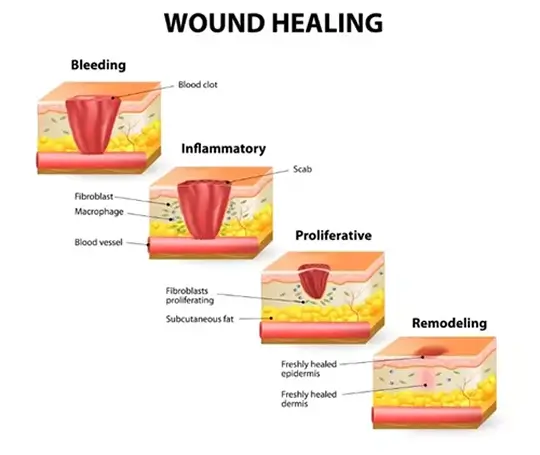Wet HealingTattoo
Wet Healing Tattoo and its benefits that every paramedical tattoo artist must know


Today we’ll discuss reasons why wet healing tattoo, also known as moist healing, is more beneficial for your paramedical tattoo.
While there are set of rules and protocols for the preparation of paramedical tattoo artists, aftercare appears to vary from artist to artist. Adding the extra intricacy of tattooing damaged skin makes aftercare even more difficult. =
Wet healing a tattoo is More Beneficial For You
WET HEALING VS. DRY HEALING AND EVERYTHING YOU SHOULD KNOW ABOUT IT
What is wet recovery? Wet healing is the treatment of any wound in a moist rather than dry environment.
Now, let’s examine some advantages of wet healing your paramedical tattoo.
01ACCELERATES THE PROCESS OF HEALING
Compared to dry dressings, studies indicate that moist dressings expedite the wound healing process in patients. Since Paramedical Tattoos are essentially wounding, they fall into the same category.
Before the introduction of wet healing, wound dressings were primarily used to absorb fluid and prevent infection. However, it was discovered that if the body were prevented from building a scab over the wound, it would heal more quickly and effectively.
02REDUCES THE PROBABILITY OF INFECTION
In addition to requiring less time, wet healing reduces the possibility of infection in your paramedical tattoo. It also facilitates the operation of specialized skin cells, such as the keratinocyte cells that aid in wound closure.
Vitamin K is essential to this process because Protein C, an essential component of keratinocyte activity, is a Vitamin-K-dependent glycoprotein. In another article, The Nutrition Source explains how Vitamin K aids the healing process by promoting appropriate blood clotting, which is essential for paramedical tattoos that bleed during the healing process.
03REDUCES TATTOO DISCOMFORT
Wet healing lessens discomfort as well. While not all tattoos are excruciatingly painful, decreasing the discomfort is crucial since it lessens the body’s stress reaction and exhaustion, facilitating speedier recovery.
Is there any possible danger of Wet Healing?
Despite its obvious advantages, moist healing has significant drawbacks if conducted improperly.
There are limitations to the wet wound healing products now available. There is still a dearth of commercial translation in clinically available therapies regarding wound- healing concepts. Therefore, you must choose the appropriate products and paramedical tattoo artist for your wet healing.
The following guidelines were developed by the American Academy of Dermatology and are recommended for optimal tattoo healing:
- Apply a suitable moisturizer: If the tattoo and the skin around it are dry, a cream or lotion based on water is recommended. We use and recommend Aquaphor. People should avoid using petroleum-based products because they accelerate the aging process.
- The area with camouflage micro pigmentation should not be exposed to the sun. Prolonged sun exposure to your camouflage and paramedical tattoos will cause the areas to darken and extend healing time.
- After two weeks, or when the tattoo is no longer an open wound, a broad-spectrum sunscreen with a minimum SPF of 30 should be applied. Apply it at least 15 minutes before heading outdoors, and reapply it every couple of hours.
- Tanning beds should be avoided at all costs. The ink in tattoos can be darkened with the help of UV lamps and tanning beds. Additionally, they are linked to an increased risk of skin cancer. Some people experience excruciating pain when exposed to UV light on their tattooed skin.
- The tattoo should be washed regularly using a fragrance-free, hypoallergenic, antibacterial soap. A paper towel to gently pat the skin dry before applying a cream is also recommended.
- People tend to over-moisturize wounds such as tattoos, especially when applying ointments; while moisture in the damage is necessary for healing, an excessive quantity can be detrimental.
- Over-moisturizing the area, might also promote the growth of yeast and fungi in your tattoo. Additionally, it can produce enzymes that aid in removing dead tissue from the wound bed and melting the healthy skin surrounding the area.
How to deal with a compromised tattoo and When To Seek Medical Attention
A tattoo that has become infected will be noticeably redder, more painful, and may even have pus or open sores. A person with a high temperature or chills should immediately see a doctor.
Reaction to allergens.
Someone can have an allergic reaction to their tattoo anytime, even years later.
Medical attention is recommended if the tattooed area develops itching, redness, swelling, scaly patches, or lumps.
Extreme reactions like trouble breathing, feeling faint, or a racing heart requires immediate medical attention.
Bottom Line
When caring for your paramedical tattoo, you must ensure it is healing appropriately from a health and aesthetic standpoint. The former is superior in both areas when comparing wet healing vs. dry healing.
We, therefore, conclude that wet healing is the preferable alternative.
Choose a trusted paramedical tattoo artist who understands wet healing and its benefits by visiting Illusions by Ink Studio.
We hope this article was helpful and gave you valuable knowledge on wet healing and its advantages!
